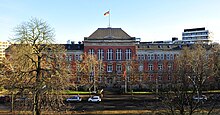|
Artillerie Prüfungskommission The Artillerie Prüfungskommission, (Artillery Test Commission) was founded in 1809 as part of the artillery of the Prussian Army. It was responsible for answering technical questions, testing the quality of new artillery materiel, and executing experiments. The Artillerie Prüfungskommission later became part of the Imperial German Army. Other nations had equivalent authorities, e.g. the Austro-Hungarian was called Artilleriekomitee. The former headquarters of the Artillerie Prüfungskommission on the Bundesallee in Berlin are still standing. HistoryIn 1808, the Prussian Artillery was reorganized and put under the command of Prince August of Prussia. On 17 March 1809, King Frederick William III ordered the establishment of a special commission for Artillery affairs. Prince August became its first president.[1] That same year, Johann Christian von Pontanus got in charge. The government also wanted Gerhard von Scharnhorst to become in involved, but he declined because of having too much work.[2] On 29 February 1816 the kommission was renamed Artillerie Prüfungskommission (APK). The Artillerie Prüfungskommission (APK) consistited of senior Prussian officers. In 1871, it consisted of: The president; Those who were members on account of their office; The Feuerwerksmeister of the Artillery; The director of the Spandau gun foundry; The first teacher of the united artillery and engineering schools; and some special appointees.[3] The APK had to answer all artillery questions that were laid before it. It also had to test materiel and execute experiments regarding new developments. Therefore, a testing department was founded from the APK's staff. In 1869, the testing department got a special artillery company to conduct these tests.[3][4] After the German unification, the APK became part of the Imperial German Army. By 1881 there were also Bavarian, Saxon, and Württemberg artillery officers sent to the APK. In Saxony, there was still a separate Artillerie Kommission. The eponymous Bavarian Artillerie Prüfungs Kommission was disbanded in 1878.[4] In April 1883, the APK was split in two departments: Abteilung I (Feldartillerie) and Abteilung II (Fußartillerie). The department chiefs had the rank and pay of a regimental commander. The APK also had a depot authority, an artefact collection and an Ersatz-Bataillon. In 1909, the APK celebrated its centenary.[5] After World War I, the APK was disbanded in late October 1919. It was replaced by the Inspektion für Waffen der Reichswehr. This was led by general Karl Becker. In the mid-1920s this led to the 'Inspektion für Waffen und Gerät' of the Heereswaffenamt(HWA). SignificanceThe Artillerie Prüfungskommission (APK) played a significant role in the development of the Prussian (Krupp) rifled breechloading field guns, which were so important during the 1870/1 Franco-Prussian War. The APK was also important in promoting the development of the German naval guns. In general, the private arms industry of Germany was also content with the APK.[5] (Artillery) rangesJungfernheide/TegelAs of 1824, the exercise grounds in Jungfernheide included an (artillery) range.[6] In 1828 the Reinickendorfer Artillerie-Schießplatz was moved to this location. The range then became known as the Tegel Range (Schießplatz Tegel). The range was in use till about 1875. Berlin Tegel Airport is now in this location. The Königliche Preußische Gewehrfabrique and Spandau gunpowder factories were near this location. The increased effective range of guns, security concerns, and the increased population density made the establishment of a new range at Kummersdorf necessary. JüterbogIn 1864 an artillery range was taken into use in Jüterbog. In 1886 the APK started large scale exercises against a mock fortress target made after Prussian and French examples.[7][8] KummersdorfIn about 1875, the range at Kummersdorf was taken into use. After World War I, the Heeresversuchsanstalt Kummersdorf was built here. With the end of World War II, shooting at this range ended. Some notable presidents
Notable members In alphabetic order
OfficesBetween 1893 and 1895 the military construction office Berlin VII headed by the Geheimen Oberbaurates Bernhardt and the architect Josef Wieczorek[19] built a new office for the APK on what was then named Kaiserallee, and is now named Bundesallee.[20] The APK used the building until 1918. The officers Erich Hoepner and Henning von Tresckow, who participated in the 1944 20 July plot, worked in the former APK office. There is a monument to them in the courtyard of the building. After World War II, the damaged building was renovated. On 17 April 1950 it was reopened as the Bundeshaus. Until 1990 this housed the plenipotentiary of the German federal government as well as the representatives of several German ministeries. Gallery
Notes
External linksWikimedia Commons has media related to Königlich-Preußische Artillerie-Prüfungskommission. References
|
Portal di Ensiklopedia Dunia



